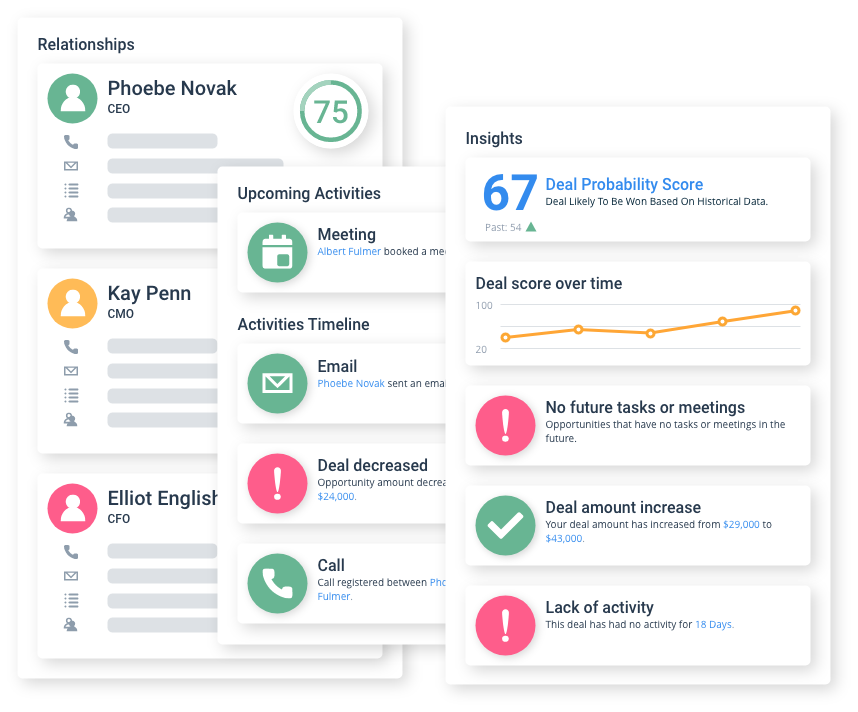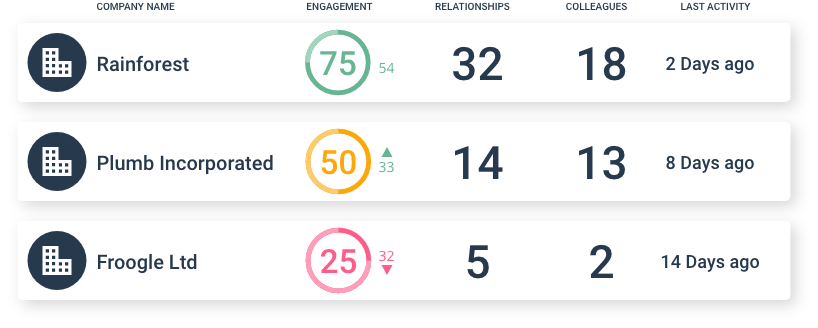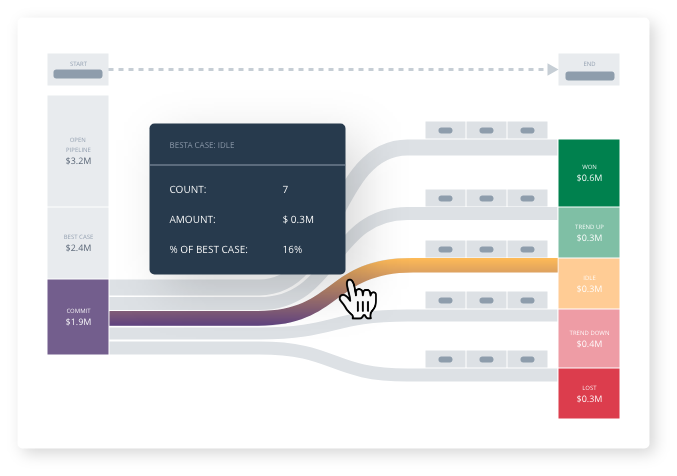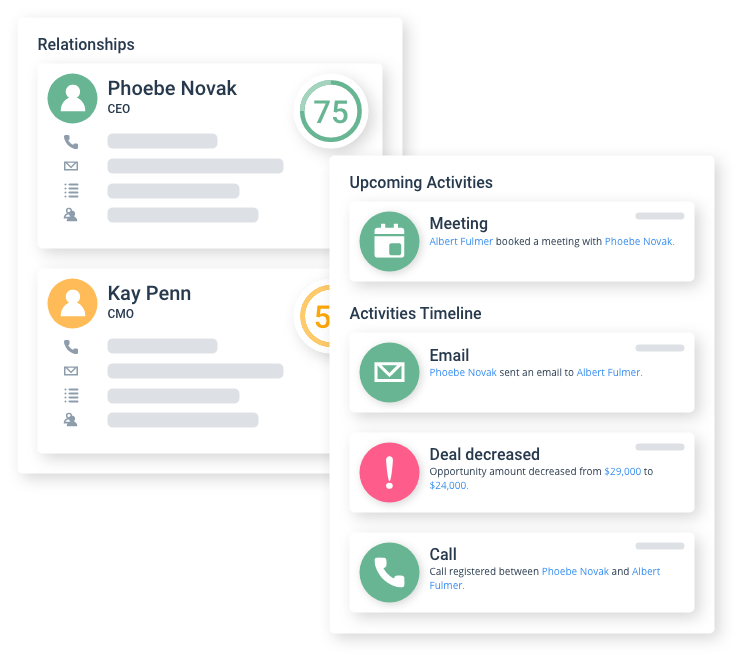Table of Contents
Share this article
Learn from the brightest minds how to predictably and efficiently grow revenue.
Related Content
Bringing Revenue Intelligence to Salesforce
Have you ever tried to build furniture without the instructions? You can follow your gut and may end up with a completed project – but there will always be a few screws left over. Your sales team can feel like that too. Their CRM may show them the parts – but without the data and…
See how forecast submissions have changed with Ebsta Waterfall
Waterfall Chart shows how your team's commit and upside forecasts have changed, and more importantly - understand which opportunities drove this change.
The Ultimate Forecast Submission Tool for Managers
New view for managers to review their teams pipeline, inspect their opportunities and change the forecast status.

What is pipeline health – and how do you solve it when it’s at risk?
Understanding how your sales pipeline is performing is key to generating sales – without a healthy flow of leads coming into and moving along your pipeline, sales begin to stagnate and revenue begins to drop. Needless to say, sales leaders and managers need to be aware of this essential insight to ensure future success. So, how measured and actioned upon?
In the article below, we will break down the KPIs that you should be tracking for a holistic overview of your pipeline health. Additionally, we will introduce you to how Ebsta’s Revenue Intelligence Platform which empowers you with the real-time insights you need to understand your pipeline and drive predictable revenue growth.
Table of Contents
Which key performance indicators should you monitor to track pipeline health?
How do you know what you are looking for and what you need to act on? Below are the main KPIs that you need to monitor to determine how healthy your pipeline is and identify which actions need to be taken to improve it.
Opportunities with no activity completed or future tasks planned
Identifying why there has been no activity on an account can be a difficult and time-consuming task, there can be multiple reasons for the lack of activity; from reps not updating the CRM to failed cadences or sales teams lacking time and resources. However, ensuring that sales reps are building their individual pipelines with tasks and diary dates is key to keeping your pipeline moving and on target. Having opportunities with no activities completed or tasks pending is a red flag and can mean an opportunity could slip from lack of engagement.

Platforms such as Ebsta automatically update your CRM by tracking and logging all your reps emails and phone call/meeting requests, so you know if your reps are actively reaching out to prospects. They can also help to highlight accounts that have not seen any outreach or follow-ups occur within a selected period, helping you to focus your sales staff on the accounts that need attention and continuously push them through the pipeline.
Deals with low engagement or not enough relationships

Ebsta provides you with a score for each of your opportunities based on how your prospective stakeholders are responding to your team’s activities and grading those interactions across the overall account. Our score is based on several factors:
- Type & Quality of Interaction
- Volume of Interactions
- Direction of Interactions
- Recency of Interactions
If your engagement score is low then your approach isn’t gaining any meaningful responses from the targeted advocates or stakeholders that need to be addressed.
Our engagement score also takes into account how many relationships you have within a prospective company. If you have few contacts within the business, then no matter the progress you are making with a single stakeholder, it is unlikely to close quickly or successfully without your reps connecting with more advocates or stakeholders to push the deal through. Ebsta maps your internal network of contacts across each rep, enabling your reps to leverage contacts and relationships to engage with the right people and strengthen the overall engagement across the target business.
Based on the score, you have a clear indication of the health of the relationships within the account and where you need to focus your efforts.
Deals stuck too long in stage or moved back
Having a deal stuck in your pipeline moving back in stages or just not moving at all is a primary concern for all involved. The longer a deal stays in a stage or between stages means it is less likely to close as it loses momentum.
By using Ebsta’s Flowchart, you can quickly and easily identify which deals have stalled with its at-a-glance breakdown of where your opportunities are across your pipeline. Furthermore, by using Flowchart’s dynamic chart you can gain an in-depth insight into the health of your opportunities; seeing how the opportunity has progressed through the sales process, what has happened to it and how long it has been in each stage. This enables you to build a picture of deals that have been stuck idle for long periods. By diving into individual opportunities you can see who owns it, how valuable it is, what stage it is at, how long has it been in this stage, how engaged are we, and how many stakeholders there are. This makes it simple to find where the roadblocks or bottlenecks are by letting you drill into each opportunity to understand exactly why it hasn’t moved or has been held back.

Not enough time to close or close date pushed out
Predicted deal close dates are key for your forecasting as they are the clearest indication of whether a deal will complete before your sales period ends. If a deal close date moves it can have a drastic impact on your forecast, potentially resulting in a missed quota. However, using revenue intelligence tools to understand why deals have been pushed back or miss their projected close dates helps you to work with reps to potentially fix any issues causing the push out and speed the deal back up. Ebsta’s in-depth 360O view of each of your opportunities allows you to delve into the events around the slip and diagnose what has happened.

Furthermore, as Ebsta uses your historical data it can identify the nominal amount of time that your sales teams need to move deals through the pipeline stages to close based on the various factors around them (size of the deal, size of company, industry). By using your data, Ebsta benchmarks where your deals are currently against that predicted nominal time you can quickly identify deals that are unlikely to close in time and take remedial action.
Deal value decreased
Deal value changes are one of the key indicators of deal health for sales leadership and can help you to identify how your pipeline is trending. However, for many sales managers having visibility on how or why these changes happen can be problematic. This is especially true with CRMs like SalesForce which might not have all the insights instantly available for review, which has lead to a reliance on sales reps to get updates; who might not be as forthcoming.
This is why our revenue intelligence platform can help you to identify where your potential risk lies and help to understand what caused the changes in deal value. With our Flowchart tool, sales managers can get an overview of the changes across the pipeline every week; giving you instant awareness of any week-to-week change in the overall pipeline value. By utilizing this overview you can see where potential risks are and identify accounts where deals may have slipped or trended down. You can then drill into the individual opportunities to more effectively identify the reasons behind any changes, giving you the awareness of events to either take action or coach reps.
Using Pipeline health insights in your review meetings
Armed with this knowledge of where your pipeline is and what is happening within it sales leadership cannot only see what is going on within the pipeline but also more effectively take action to optimize it. One of the key aspects of this is pipeline review meetings. A review meeting allows the sales team to analyze the health and performance of the pipeline to know where to focus their efforts going forward. We are sure that you have had review meetings before, but have they been as effective as they could have been?
So how do you run an effective pipeline review?
A key aspect that makes pipeline reviews effective is making them strategic and focused. By using the data and insight that are instantly accessible from tools like Ebsta, you can easily get an overview of exactly what is happening within your pipeline removing much of the back and forth questioning reps on the status of their world. Armed with the exact and up-to-date insights and information your meetings become more tactical and objective-driven.
By taking this strategic approach to the review, you can understand how pipeline is progressing and ultimately answer the key questions around the health of the pipeline:
- What has changed with specific deals?
- What has happened in this deal stage?
- How likely are the deals to close?
- What is the engagement for the deals?
For more infortmation, we’ve covered running an effective pipeline review meeting in a previous article.
How Revenue Intelligence Platforms help you to understand your pipeline health?
Revenue Intelligence Platforms, like Ebsta, offer you complete visibility over your pipeline and sales process. By combining data points from across the business with analytics, platforms ensure that sales leaders and managers have the insight they need to make decisions based on actionable data instead of subjective guesses from sales teams.
Revenue Intelligence Platforms benchmark your current sales data against your own historical data to provide you with unique and individualized intelligence, sourced from your wins and losses. By building the data from your source you can be assured that the insights accurately show your sales trends over time. This then gives you confidence in knowing how your sales pipeline is moving and provides the insight needed to understand how your sales teams and pipeline are performing, so you can accurately forecast sales and revenue.
By using a Revenue Intelligence Platform to track your sales data you can more effectively determine the health of your pipeline, by giving you the insight needed to identify where your risk is and how to combat it. Furthermore, with historical data, you identify trends within your sales pipeline and process – which can either be exploited to improve revenue or optimized to reduce risk.
Interested in finding out for yourself, speak to our sales team to arrange a demo.
